Choosing the right atomizer for your perfume can significantly impact its preservation, application, and overall experience. The two most common materials for perfume atomizers are glass and plastic. While both serve the basic function of dispensing fragrance, they differ significantly in terms of durability, chemical compatibility, aesthetic appeal, and cost. This article will delve into a detailed comparison of glass and plastic perfume atomizers to help you make an informed decision.
Durability and Longevity
One of the primary considerations when choosing between glass and plastic is durability. Glass atomizers are generally more robust and resistant to scratches and cracks compared to plastic. High-quality glass is less likely to degrade over time, maintaining its integrity even with frequent use. This makes glass atomizers a better long-term investment, especially for expensive fragrances.
Plastic atomizers, on the other hand, are more prone to scratching and can become brittle over time, especially when exposed to sunlight or extreme temperatures. Cheaper plastics can also crack or break more easily if dropped. However, some advanced plastics, like Tritan or PET, offer improved durability compared to standard plastics. Despite these advancements, glass typically remains the more durable option.
Chemical Compatibility
Perfumes contain a complex blend of fragrant oils, solvents, and fixatives. The material of the atomizer must be chemically compatible with these ingredients to prevent degradation of the perfume or leaching of the atomizer material into the fragrance. Glass is inherently inert and non-reactive, making it an ideal choice for storing perfumes. It does not interact with the perfume’s components, ensuring the fragrance remains unchanged over time.
Plastic, however, can react with certain perfume ingredients, particularly alcohol and essential oils. This can lead to the plastic degrading, discoloring, or even releasing chemicals into the perfume, altering its scent profile. While some plastics are designed to be more chemically resistant, it’s crucial to choose plastics specifically formulated for storing fragrances. PET (polyethylene terephthalate) and HDPE (high-density polyethylene) are commonly used plastics for perfume atomizers due to their relatively good chemical resistance, but they are still not as inert as glass.
Aesthetic Appeal
The aesthetic appeal of a perfume atomizer contributes significantly to the overall user experience. Glass atomizers often exude a sense of luxury and sophistication. The clarity of glass allows you to see the perfume inside, adding to its visual appeal. Glass atomizers are also available in various shapes, sizes, and designs, from classic and elegant to modern and minimalist.
Plastic atomizers, while generally less luxurious in appearance, offer greater versatility in terms of color and design. They can be molded into virtually any shape and can be easily colored or decorated. This makes plastic atomizers a popular choice for brands seeking to create unique and eye-catching packaging. However, the overall aesthetic is often perceived as less premium compared to glass.
Coste
Cost is a significant factor for both consumers and manufacturers. Plastic atomizers are generally less expensive to produce than glass atomizers. This makes them a more economical choice for mass-market perfumes and travel-sized atomizers. The lower cost also allows for greater flexibility in design and customization without significantly increasing the overall price.
Glass atomizers, due to the more complex manufacturing process and the higher cost of raw materials, are typically more expensive. However, the added cost is often justified by the increased durability, chemical compatibility, and aesthetic appeal. For high-end perfumes and those seeking to preserve their fragrance for extended periods, the investment in a glass atomizer is often worthwhile.
Impacto medioambiental
The environmental impact of glass and plastic atomizers is a growing concern. Glass is a highly recyclable material and can be recycled endlessly without losing its quality. This makes glass a more sustainable option compared to plastic, especially when considering the long-term impact on the environment. However, the energy required to manufacture and transport glass is relatively high.
Plastic, while recyclable, often faces challenges in the recycling process. Not all types of plastic are easily recyclable, and the recycling infrastructure varies significantly across different regions. Furthermore, the recycling process can degrade the quality of plastic, limiting the number of times it can be recycled. Single-use plastic atomizers contribute significantly to plastic waste and pollution. The development and use of biodegradable or recycled plastics are promising avenues for reducing the environmental impact of plastic atomizers.
Weight and Portability
Weight and portability are important considerations, particularly for travel atomizers. Plastic atomizers are significantly lighter than glass atomizers, making them more convenient for carrying in a purse or travel bag. The lighter weight also reduces the risk of damage during transport.
Glass atomizers, due to their heavier weight, may be less ideal for travel. However, the added weight also contributes to their perceived quality and sturdiness. For those prioritizing durability and fragrance preservation, the slightly heavier weight may be an acceptable trade-off.
Comparison Table
| Feature | Glass Atomizer | Plastic Atomizer |
|---|---|---|
| Durability | High, resistant to scratches and cracks | Lower, prone to scratching and cracking |
| Chemical Compatibility | Excellent, inert and non-reactive | Variable, can react with certain ingredients |
| Aesthetic Appeal | High, luxurious and elegant | Variable, versatile in design and color |
| Coste | Higher | Lower |
| Impacto medioambiental | More sustainable, easily recyclable | Less sustainable, recycling challenges |
| Weight | Heavier | Lighter |
Conclusión
The choice between glass and plastic perfume atomizers depends on individual preferences and priorities. Glass atomizers offer superior durability, chemical compatibility, and aesthetic appeal, making them ideal for preserving and showcasing high-end fragrances. While more expensive and heavier than plastic, the long-term benefits and sustainable nature of glass make it a worthwhile investment for many. Plastic atomizers, on the other hand, provide a more cost-effective and lightweight option, suitable for mass-market perfumes and travel-sized containers. The versatility of plastic in terms of design and color makes it a popular choice for brands seeking unique packaging. However, it is crucial to select plastics specifically formulated for fragrance storage to minimize the risk of chemical interactions. Ultimately, understanding the strengths and weaknesses of each material will enable you to choose the perfume atomizer that best meets your needs and enhances your fragrance experience.
Preguntas más frecuentes (FAQ)
















Dejar una respuesta